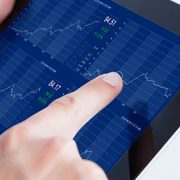Tablet Computing For Businesses
2011 is the year of the tablet and as the year comes to a close; we’ll explore how this new technology is changing the business landscape. A recent article in eMarketer reports that 33.7 million Americans use a tablet on a monthly basis; an increase of 158.6% percent over 2010. eMarketer goes on to project that 90 million Americans will be using tablets by 2014. What does this mean for business? In short — a lot!
Although today’s tablets are not full replacements for business laptops and workstations, they do provide significant mobility options for the workforce. Open Forum reports that businesses will comprise over a quarter of the tablet market, complimenting their usage of smartphones as well as replacing some duties currently performed by laptops.
Pros and Cons:
Tablets are large enough to do some work, but light enough to easily travel with. They also have long battery lives making them useable for longer periods of time than laptops while away from a power source. However, keep in mind that tablets don’t have keyboards and their smaller screen size makes it uncomfortable to do serious database, spreadsheet, and word processing work. These shortcomings make them, in my opinion, unlikely to unseat the laptop and workstation from their current business pedestals.
Questions to ask before buying a tablet:
So, if a tablet is not yet as powerful as a laptop, how can a business use them? Like any answer that is technology-related, a business has to evaluate its needs first:
- What operating system are you planning on using? Currently, there are three major players: Apple iOS, Android, and Blackberry. Apple and Android are the current leaders and in my opinion, the only ones to consider at this time.
- Is the software used in your business Microsoft-based? Although non-Microsoft OS based tablets cannot directly run Microsoft software, there are many apps on the market that allow users to create, edit, and view basic MS files, such as Word, Excel, and PowerPoint. Investigate the apps on the market to make sure that you get the one that has the capabilities you need.
- Do you plan on mainly using apps on your device? Apple and Android-based systems have thousands of useful apps. However, you need to check to see that the ones you need are offered for your device. Not all apps have Apple and Android versions.
- Will you be using primarily Cloud applications instead of installed programs? For Cloud computing (i.e. SalesForce.com, Google Docs, etc.) the device is not as important as the browser that you use. As long as your device of choice can run a compatible browser, you should be OK.
- Do you need Wi-Fi only or will you also need 3G service? Wi-Fi (wireless) is commonly available in business sites, homes, and some retail locations (i.e. Starbucks, etc.). Depending on who is using the device, will they need 3G capabilities for those times when Wi-Fi is not available? Keep in mind that 3G comes at an additional cost from your wireless provider.
Business uses for a tablet:
- Basic MS Office compatible apps – there are a few apps that do a good job of allowing users to create and/or read MS Word, Excel, and PowerPoint compatible files. If this is a crucial point, check out the apps available for the device you plan to purchase BEFORE you buy it.
- Email and Calendar – these are basic utilities that no business can do without. Like smartphones, these apps can be synched with the office server.
- Video calls and conferencing – this is one of the most exciting uses since a tablet’s larger screen size makes video conferencing a much better experience than those offered on smartphones. Businesses using their tablets in this manner are often looked upon as technology-savvy companies by their prospects.
- On-the-go Presentations – many businesses give tablets to their sales forces that use them to give one-on-one presentations to prospects. Again, businesses using a tablet in this way are perceived as technologically proficient. Indeed, PCWorld reports that over 45% of businesses use them for customer presentations.
- PC remote access – there are many apps that will allow users to remote control their business computers allowing them to use software and in-house applications that cannot be run on their tablets (at least not at this time). Although this may not be the optimal approach, this capability is quite useful for people-on-the-go.
- Social Media – all of the major social media platforms (i.e. Facebook, Twitter, etc.) have apps that will allow users to access their accounts.
- Apps, apps, and more apps – there are a multitude of apps that allow users to scan documents, read PDF files, print documents on-the-go, track expenses and billable hours, travel, etc.; and the good news — more are being built everyday increasing tablet (and smartphone) productivity.
Apple versus Android:
Let’s face it Apple makes cool and easy-to-use devices. Their software is intuitive. In most cases, you just take an Apple device out of the box and use it. The biggest problem I see with Apple is its closed architecture. Apple simply does not license its software out, therefore, any additional functionality will only come if Apple decides to create it or approve an app to do it.
The open architecture of Android allows for greater customization and although the number of Apps at Apple’s disposal beats Android for now, that will surely change in the future. Getting an app into the Android market is much less daunting than getting that same app approved by Apple. So, if you need your Android to do something, an app is either available for it or it won’t be long before a developer creates it.
Another factor is the hardware itself. With Apple, you do not have many choices at all; however, many manufacturers are creating Android tablets with different screen sizes, SD card expansion slots, and USB peripheral and mass storage options.
The variety of hardware and software choices makes Android hard to beat for business tablet computing.
Tablet Choices to consider:
The tablet market is getting more crowded by the minute. A quick search using your favorite search engine will undoubtedly unearth a plethora of choices. Here’s a few to check out. Their prices range from $399 to $860:
These are not the only ones on the market and you should do your research to find the one that’s best for your business needs. Here are two links that will help you evaluate some of the choices available:
- 2012 Best Tablet Side-by-Side Comparisons and Reviews (TopTenReviews)
- Top 10 Tablets (PCWorld)
Conclusion:
Tablets have a place in business but will not likely replace laptops and workstations in the near future. However, they can and should be incorporated into a company’s IT mix where it makes sense. Outside sales forces and field workers can benefit from their portability, long battery life, available productivity apps ,web access and cloud computing usefulness, video conferencing and presentation capabilities. As tablets become more powerful and our workforces more mobile they will become indispensable as a business tool.
I think those people who see the tablet as leading to the demise of workstations and laptops are wrong. Laptops/workstations, smartphones, and tablets will all be integral parts of the business landscape. It just makes sense to rely on a laptop/workstation for computing in the office because of its unquestioned power; the smartphone will be used on-the-go when it is impractical to carry anything larger; and the tablet — more powerful than a smartphone but less dominant than a laptop — will be used to bridge the gap between the office and the places we travel to.
With the coming of the tablet, the mobile office has become a reality. My advice— get on board or be left behind.











